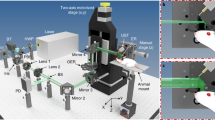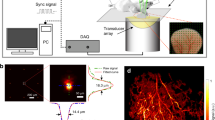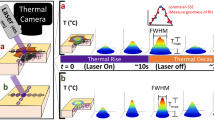Abstract
Functional photoacoustic microscopy (fPAM) is a hybrid technology that permits noninvasive imaging of the optical absorption contrast in subcutaneous biological tissues. fPAM uses a focused ultrasonic transducer to detect high-frequency photoacoustic (PA) signals. Volumetric images of biological tissues can be formed by two-dimensional raster scanning, and functional parameters can be further extracted from spectral measurements. fPAM is safe and applicable to animals as well as humans. This protocol provides guidelines for parameter selection, system alignment, imaging operation, laser safety and data processing for in vivo fPAM. It currently takes ∼100 min to carry out this protocol, including ∼50 min for data acquisition using a 10-Hz pulse-repetition-rate laser system. The data acquisition time, however, can be significantly reduced by using a laser system with a higher pulse repetition rate.
This is a preview of subscription content, access via your institution
Access options
Subscribe to this journal
Receive 12 print issues and online access
$259.00 per year
only $21.58 per issue
Buy this article
- Purchase on Springer Link
- Instant access to full article PDF
Prices may be subject to local taxes which are calculated during checkout




Similar content being viewed by others
References
Xu, M. & Wang, L.V. Photoacoustic imaging in biomedicine. Rev. Sci. Instrum. 77, 041101 (2006).
Wang, X. et al. Noninvasive laser-induced photoacoustic tomography for structural and functional imaging of the brain in vivo. Nat. Biotechnol. 21, 803–806 (2003).
Hoelen, C.G.A., de Mul, F.F.M., Pongers, R. & Dekker, A. Three-dimensional photoacoustic imaging of blood vessels in tissue. Opt. Lett. 23, 648–650 (1998).
Oraevsky, A.A. & Karabutov, A.A. Optoacoustic Tomography. in Biomedical Photonics Handbook, Vol. PM125 (ed. Vo-Dinh, T.) (CRC Press, Boca Raton, Florida, 2003).
Kruger, R.A., Liu, P., Fang, Y.R. & Appledorn, C.R. Photoacoustic ultrasound (PAUS)—reconstruction tomography. Med. Phys. 22, 1605–1609 (1995).
Bell, A.G. On the production and reproduction of sound by light. Am. J. Sci. 20, 305–324 (1880).
Diebold, G.J., Khan, M.I. & Park, S.M. Photoacoustic “signature” of particulate matter: optical production of acoustic monopole radiation. Science 250, 101–104 (1990).
Tam, A.C. Applications of photoacoustic sensing techniques. Rev. Mod. Phys. 58, 381–431 (1986).
Oleary, M.A., Boas, D.A., Chance, B. & Yodh, A.G. Experimental images of heterogeneous turbid media by frequency-domain diffuse-photon tomography. Opt. Lett. 20, 426–428 (1995).
Boas, D.A. et al. Imaging the body with diffuse optical tomography. IEEE Signal Processing Mag. 18, 57–75 (2001).
Duck, F.A. Physical Properties of Tissue (Academy Press, London, 1990).
Maslov, K., Stoica, G. & Wang, L.V. In vivo dark-field reflection-mode photoacoustic microscopy. Opt. Lett. 30, 625–627 (2005).
Zhang, H.F., Maslov, K., Stoica, G. & Wang, L.V. Functional photoacoustic microscopy for high-resolution and noninvasive in vivo imaging. Nat. Biotechnol. 24, 848–851 (2006).
Zhang, H.F., Maslov, K., Li, M.-L., Stoica, G. & Wang, L.V. In vivo volumetric imaging of subcutaneous microvasculature by photoacoustic microscopy. Opt. Express. 14, 9317–9323 (2006).
Zhang, H.F., Maslov, K., Sivaramakrishnan, M., Stoica, G. & Wang, L.V. Imaging of hemoglobin oxygen saturation variations in single vessels in vivo using photoacoustic microscopy. Appl. Phys. Lett. 90, 052901 (2007).
Oh, J.-T., Li, M.-L., Zhang, H.F., Maslov, K., Stoica, G. & Wang, L.V. Three-dimensional imaging of skin melanoma in vivo by dual-wavelength photoacoustic microscopy. J. Biomed. Opt. 11, 034032 (2006).
Zhang, H.F., Maslov, K., Stoica, G. & Wang, L.V. Imaging acute thermal burns by photoacoustic microscopy. J. Biomed. Opt. 11, 054033 (2006).
Li, L., Zemp, R.J., Lungu, G., Stoica, G. & Wang, L.V. Imaging of gene expression in vivo with photoacoustic tomography. Proc. SPIE 6086, 62–67 (2006).
Maslov, K., Sivaramakrishnan, M., Zhang, H.F., Stoica, G. & Wang, L.V. Technical considerations in quantitative blood oxygenation measurement using photoacoustic microscopy in vivo . Proc. SPIE 6086, 215–225 (2006).
Briggs, G.A.D. Acoustic Microscopy (Clarendon, Oxford, 1992).
Laser Institute of America, American National Standard for Safe Use of Lasers ANSI Z136.1-2000, (American National Standards Institute Inc., New York, NY, 2000).
Li, M.-L., Zhang, H.F., Maslov, K., Stoica, G. & Wang, L.V. Improved in vivo photoacoustic microscopy based on a virtual-detector concept. Opt. Lett. 31, 474–476 (2006).
Brown, D.G. & Riederer, S.J. Contrast-to-noise ratio in maximum intensity projection images. Magn. Reson. Med. 23, 130–137 (1992).
Anderson, C.M., Saloner, D., Tsuruda, J.S., Shapeero, L.G. & Lee, R.E. Artifacts in maximum-intensity-projection display of MR angiograms. Am. J. Roentgenol. 154, 623–629 (1990).
Laufer, J., Deply, D., Elwell, C. & Beard, P. Quantitative spatially resolved measurement of tissue chromophore concentrations using photoacoustic spectroscopy: application to the measurement of blood oxygenation and haemoglobin concentration. Phys. Med. Biol. 52, 141–168 (2007).
Wilson, B.C. & Jacques, S.L. Optical reflectance and transmittance of tissues: principles and applications. IEEE J. Quant. Electron. 26, 2186–2199 (1990).
Acknowledgements
We thank G. Stoica, O. Craciun, J. Oh, G. Ku, M.-L. Li, X. Xie, G. Lungu, R. Zemp and M. Sivaramakrishnan for experimental assistance. This work was sponsored by grants from the National Institutes of Health (R01 EB000712 and R01 NS46214 to L.V.W.).
Author information
Authors and Affiliations
Corresponding author
Ethics declarations
Competing interests
The authors declare no competing financial interests.
Rights and permissions
About this article
Cite this article
Zhang, H., Maslov, K. & Wang, L. In vivo imaging of subcutaneous structures using functional photoacoustic microscopy. Nat Protoc 2, 797–804 (2007). https://doi.org/10.1038/nprot.2007.108
Published:
Issue Date:
DOI: https://doi.org/10.1038/nprot.2007.108
This article is cited by
-
Ultrafast longitudinal imaging of haemodynamics via single-shot volumetric photoacoustic tomography with a single-element detector
Nature Biomedical Engineering (2023)
-
Snapshot photoacoustic topography through an ergodic relay of optical absorption in vivo
Nature Protocols (2021)
-
Photoacoustic-based visual servoing of a needle tip
Scientific Reports (2018)
-
Photoacoustic microscopy: principles and biomedical applications
Biomedical Engineering Letters (2018)
-
Development of a Fiber Laser with Independently Adjustable Properties for Optical Resolution Photoacoustic Microscopy
Scientific Reports (2016)
Comments
By submitting a comment you agree to abide by our Terms and Community Guidelines. If you find something abusive or that does not comply with our terms or guidelines please flag it as inappropriate.



